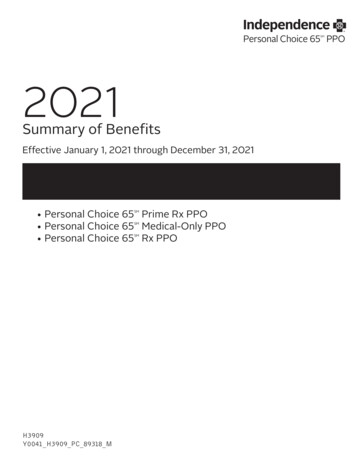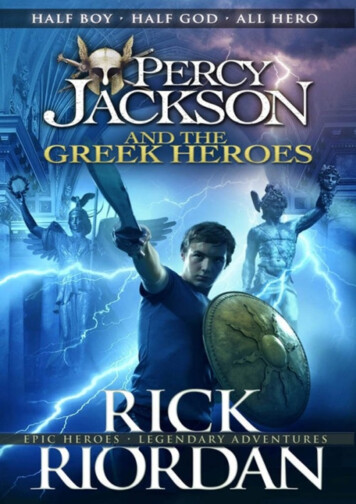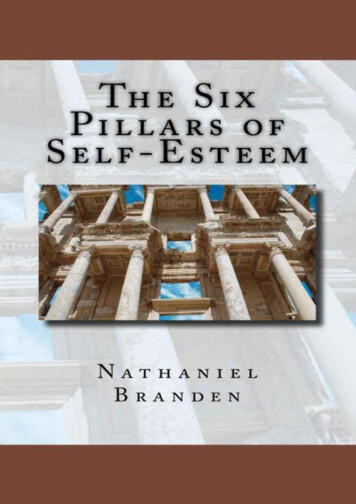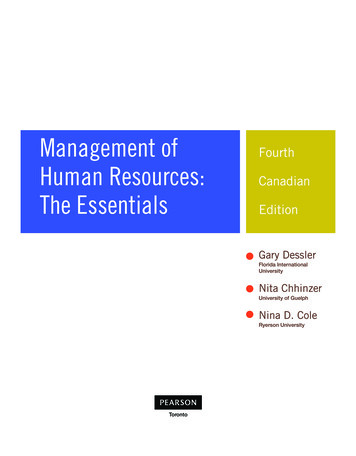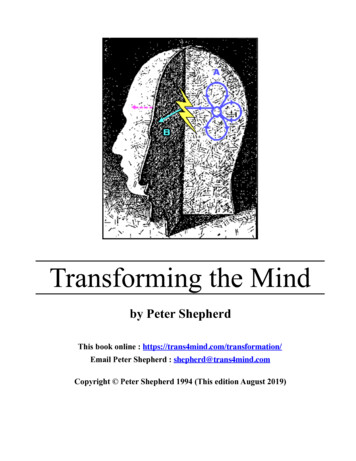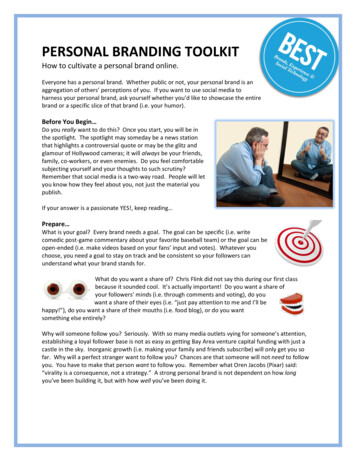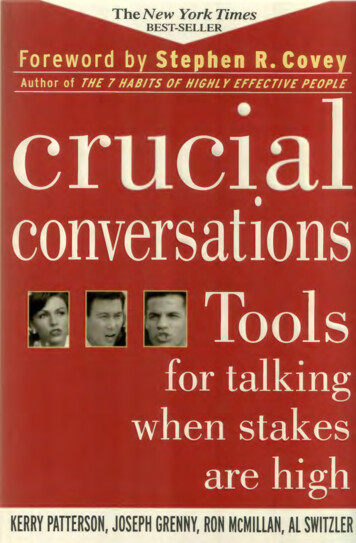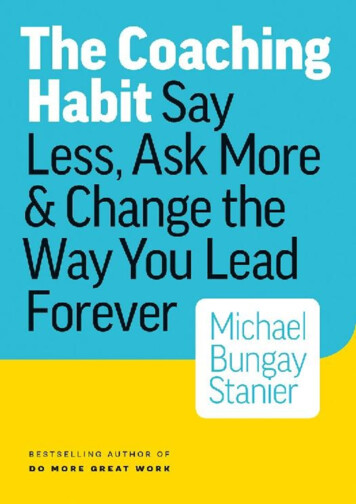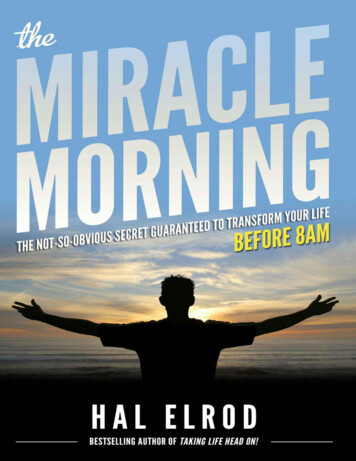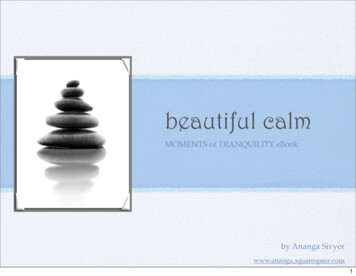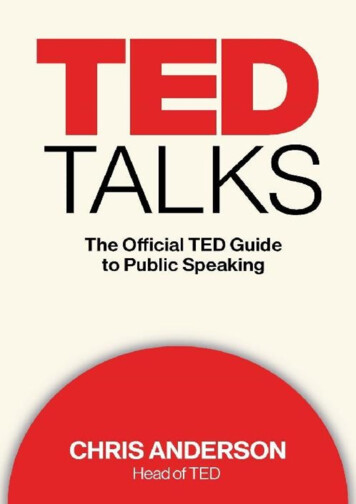
Transcription
OceanofPDF.com
CONTENTSTitle PageContentsCopyrightDedicationThe New Age of FireFoundationPresentation LiteracyIdea BuildingCommon TrapsThe ThroughlineTalk ationPreparation Proces sVisualsScriptingRun-ThroughsOpen and CloseOn StageWardrobeMental PrepSetupVoice and PresenceFormat InnovationReflectionTalk RenaissanceWhy This MattersYour TurnAcknowledgmentsTalks Referenced within the Book
IndexTED on the WebAbout the AuthorFootnotesOceanofPDF.com
Copyright 2016 by Chris AndersonAll rights reservedFor information about permission to reproduce selections from this book,write to trade.permissions@hmhco.com or to Permissions, Houghton MifflinHarcourt Publishing Company, 3 Park Avenue, 19th Floor, New York, NewYork 10016.www.hmhco.comThe Library of Congress has cataloged the print edition as follows:Names: Anderson, Chris, date.Title: TED talks : the official TED guide to public speaking / Chris Anderson.Description: Boston : Houghton Mifflin Harcourt, 2016. Includes index.Identifiers: LCCN 2015048798 ISBN 9780544634497 (hardcover) ISBN9780544809710 (international edition pbk.)Subjects: LCSH: Public speaking—Handbooks, manuals, etc.Classification: LCC PN4129.15 .A54 2016 DDC 808.5/1—dc23LC record available at http://lccn.loc.gov/2015048798Cover design by Mike FemiaeISBN 978-0-544-66436-4v1.0516OceanofPDF.com
Inspired by Zoe Anderson (1986–2010).Life is fleeting. Ideas, inspiration, and love endure.OceanofPDF.com
PrologueOceanofPDF.com
THE NEW AGE OF FIREThe house lights dim. A woman, her palms sweating, her legs trembling just alittle, steps out onto the stage. A spotlight hits her face, and 1,200 pairs ofeyes lock onto hers. The audience senses her nervousness. There is palpabletension in the room. She clears her throat and starts to speak.What happens next is astounding.The 1,200 brains inside the heads of 1,200 independent individuals start tobehave very strangely. They begin to sync up. A magic spell woven by thewoman washes over each person. They gasp together. Laugh together. Weeptogether. And as they do so, something else happens. Rich, neurologicallyencoded patterns of information inside the woman’s brain are somehowcopied and transferred to the 1,200 brains in the audience. These patterns willremain in those brains for the rest of their lives, potentially impacting theirbehavior years into the future.The woman on the stage is weaving wonder, not witchcraft. But her skillsare as potent as any sorcery.Ants shape each other’s behavior by exchanging chemicals. We do it bystanding in front of each other, peering into each other’s eyes, waving ourhands and emitting strange sounds from our mouths. Human-to-humancommunication is a true wonder of the world. We do it unconsciously everyday. And it reaches its most intense form on the public stage.The purpose of this book is to explain how the miracle of powerful publicspeaking is achieved, and to equip you to give it your best shot. But one thingneeds emphasizing right at the start.There is no one way to give a great talk. The world of knowledge is far toobig and the range of speakers and of audiences and of talk settings is far toovaried for that. Any attempt to apply a single set formula is likely to backfire.Audiences see through it in an instant and feel manipulated.Indeed, even if there were a successful formula at one moment in time, itwouldn’t stay successful for long. That’s because a key part of the appeal of agreat talk is its freshness. We’re humans. We don’t like same old, same old. Ifyour talk feels too similar to a talk someone has already heard, it is bound tohave less impact. The last thing we want is for everyone to sound the same orfor anyone to sound as though he’s faking it.So you should not think of the advice in this book as rules prescribing asingle way to speak. Instead think of it as offering you a set of tools designedto encourage variety. Just use the ones that are right for you and for thespeaking opportunity you’re facing. Your only real job in giving a talk is to
have something valuable to say, and to say it authentically in your own uniqueway.You may find it more natural than you think. Public speaking is an ancientart, wired deeply into our minds. Archaeological discoveries dating backhundreds of thousands of years have found community meeting sites whereour ancestors gathered around fire. In every culture on earth, as languagedeveloped, people learned to share their stories, hopes, and dreams.Imagine a typical scene. It is after nightfall. The campfire is ablaze. Thelogs crackle and spit under a starry sky. An elder rises, and all eyes turn andlock onto the wise, wrinkled face, illuminated by the flickering light. Thestory begins. And as the storyteller speaks, each listener imagines the eventsthat are being described. That imagination brings with it the same emotionsshared by the characters in the story. This is a profoundly powerful process. Itis the literal alignment of multiple minds into a shared consciousness. For aperiod of time, the campfire participants act as if they were a single life form.They may rise together, dance together, chant together. From this sharedbackdrop, it is a short step to the desire to act together, to decide to embarktogether on a journey, a battle, a building, a celebration.The same is true today. As a leader—or as an advocate—public speaking isthe key to unlocking empathy, stirring excitement, sharing knowledge andinsights, and promoting a shared dream.Indeed, the spoken word has actually gained new powers. Our campfire isnow the whole world. Thanks to the Internet, a single talk in a single theatercan end up being seen by millions of people. Just as the printing pressmassively amplified the power of authors, so the web is massively amplifyingthe impact of speakers. It is allowing anyone anywhere with online access(and within a decade or so, we can expect almost every village on earth to beconnected) to summon the world’s greatest teachers to their homes and learnfrom them directly. Suddenly an ancient art has global reach.This revolution has sparked a renaissance in public speaking. Many of ushave suffered years of long, boring lectures at university; interminablesermons at church; or roll-your-eyes predictable political stump speeches. Itdoesn’t have to be that way.Done right, a talk can electrify a room and transform an audience’sworldview. Done right, a talk is more powerful than anything in written form.Writing gives us the words. Speaking brings with it a whole new toolbox.When we peer into a speaker’s eyes; listen to the tone of her voice; sense hervulnerability, her intelligence, her passion, we are tapping into unconsciousskills that have been fine-tuned over hundreds of thousands of years. Skillsthat can galvanize, empower, inspire.
What is more, we can enhance these skills in ways the ancients could neverhave imagined: The ability to show—right there in beautiful high-resolution—any image that a human can photograph or imagine. The ability to weave invideo and music. The ability to draw on research tools that present the entirebody of human knowledge to anyone in reach of a smartphone.The good news is, these skills are teachable. They absolutely are. And thatmeans that there’s a new superpower that anyone, young or old, can benefitfrom. It’s called presentation literacy. We live in an era where the best way tomake a dent on the world may no longer be to write a letter to the editor orpublish a book. It may be simply to stand up and say something . . . becauseboth the words and the passion with which they are delivered can now spreadacross the world at warp speed.In the twenty-first century, presentation literacy should be taught in everyschool. Indeed, before the era of books, it was considered an absolutely corepart of education,1 albeit under an old-fashioned name: rhetoric. Today, in theconnected era, we should resurrect that noble art and make it education’sfourth R: reading, ’riting, ’rithmetic . . . and rhetoric.The word’s core meaning is simply “the art of speaking effectively.”Fundamentally, that’s the purpose of this book. To recast rhetoric for themodern era. To offer useful stepping-stones toward a new presentationliteracy.Our experience at TED over the last few years can help point the way. TEDbegan as an annual conference, bringing together the fields of technology,entertainment, and design (hence the name). But in recent years it hasexpanded to cover any topic of public interest. TED speakers seek to maketheir ideas accessible to those outside their field by delivering short, carefullyprepared talks. And to our delight, this form of public speaking has proved ahit online, to the extent that, as of 2015, more than 1 billion TED Talks areviewed annually.My colleagues and I have worked with hundreds of TED speakers, helpingfine-tune their messages and how they deliver them. These amazing peoplehave completely changed the way we see the world. Over the past decade, wehave debated passionately among ourselves how exactly these speakers haveachieved what they’ve achieved. From our lucky ringside seats, we have beenintrigued and infuriated, informed and inspired. We have also had the chanceto ask them directly for their advice on how to prepare and deliver an amazingtalk. Thanks to their brilliance, we’ve learned dozens of insights into howthey achieved something so extraordinary in just a few minutes.That makes this book a collaborative effort. It’s a collaboration with thosespeakers, and with my talented colleagues, especially Kelly Stoetzel, Bruno
Giussani, and Tom Rielly, who curate and host the main TED events with me,and who have had a central role over the years in shaping the TED Talkapproach and format and bringing remarkable voices to our platform.We have also tapped into the collective wisdom of thousands of selforganized TEDx events.2 The content emerging from them often surprises anddelights us, and it has expanded our understanding of what is possible in apublic talk.TED’s mission is to nurture the spread of powerful ideas. We don’t carewhether this is done through something called TED, TEDx, or in any otherform of public speaking. When we hear of other conferences deciding theywant to put on TED-style talks, we’re thrilled. Ultimately, ideas aren’t owned.They have a life of their own. We’re delighted to see today’s renaissance inthe art of public speaking wherever it is happening and whoever is doing it.So the purpose of this book is not just to describe how to give a TED Talk.It’s much broader than that. Its purpose is to support any form of publicspeaking that seeks to explain, inspire, inform, or persuade; whether inbusiness, education, or on the public stage. Yes, many of the examples in thisbook are from TED Talks, but that’s not only because those are the exampleswe’re most familiar with. TED Talks have generated a lot of excitement inrecent years, and we think they have something to offer the wider world ofpublic speaking. We think the principles that underlie them can act as apowerful basis for a broader presentation literacy.So you won’t find specific tips on giving a toast at a wedding, or acompany sales pitch, or a university lecture. But you will find tools andinsights that may be useful for those occasions and, indeed, for every form ofpublic speaking. More than that, we hope to persuade you to think aboutpublic speaking in a different way, a way that you will find exciting andempowering.The campfires of old have spawned a new kind of fire. A fire that spreadsfrom mind to mind, screen to screen: the ignition of ideas whose time hascome.This matters. Every meaningful element of human progress has happenedonly because humans have shared ideas with each other and then collaboratedto turn those ideas into reality. From the first time our ancestors teamed up totake down a mammoth to Neil Armstrong’s first step onto the moon, peoplehave turned spoken words into astonishing shared achievements.We need that now more than ever. Ideas that could solve our toughestproblems often remain invisible because the brilliant people in whose mindsthey reside lack the confidence or the know-how to share those ideaseffectively. That is a tragedy. At a time when the right idea presented the right
way can ripple across the world at the speed of light, spawning copies of itselfin millions of minds, there’s huge benefit to figuring out how best to set it onits way, both for you, the speaker-in-waiting, and for the rest of us who needto know what you have to say.Are you ready?Let’s go light a fire.Chris AndersonFebruary 2016OceanofPDF.com
FOUNDATIONOceanofPDF.com
Foundation1OceanofPDF.com
PRESENTATION LITERACYThe Skill You Can BuildYou’re nervous, right?Stepping out onto a public stage and having hundreds of pairs of eyesturned your way is terrifying. You dread having to stand up in a companymeeting and present your project. What if you get nervous and stumble overyour words? What if you completely forget what you were going to say?Maybe you’ll be humiliated! Maybe your career will crater! Maybe the ideayou believe in will stay buried forever!These are thoughts that can keep you up at night.But guess what? Almost everyone has experienced the fear of publicspeaking. Indeed, surveys that ask people to list their top fears often reportpublic speaking as the most widely selected, ahead of snakes, heights—andeven death.How can this be? There is no tarantula hidden behind the microphone. Youhave zero risk of plunging off the stage to your death. The audience will notattack you with pitchforks. Then why the anxiety?It’s because there’s a lot at stake—not just the experience in the moment,but in our longer-term reputation. How others think of us matters hugely. Weare profoundly social animals. We crave each other’s affection, respect, andsupport. Our future happiness depends on these realities to a shocking degree.And we sense that what happens on a public stage is going to materially affectthese social currencies for better or worse.But with the right mindset, you can use your fear as an incredible asset. Itcan be the driver that will persuade you to prepare for a talk properly.That’s what happened when Monica Lewinsky came to TED. For her, thestakes couldn’t have been higher. Seventeen years earlier, she had beenthrough the most humiliating public exposure imaginable, an experience sointense it almost broke her. Now she was attempting a return to a more visiblepublic life, to reclaim her narrative.But she was not an experienced public speaker, and she knew that it wouldbe disastrous if she messed up. She told me:Nervous is too mild a word to describe how I felt. More like . . .Gutted with trepidation. Bolts of fear. Electric anxiety. If we couldhave harnessed the power of my nerves that morning, I think the
energy crisis would have been solved. Not only was I stepping outonto a stage in front of an esteemed and brilliant crowd, but it wasalso videotaped, with the high likelihood of being made public on awidely viewed platform. I was visited by the echoes of lingeringtrauma from years of having been publicly ridiculed. Plagued by adeep insecurity I didn’t belong on the TED stage. That was the innerexperience against which I battled.And yet Monica found a way to turn that fear around. She used somesurprising techniques, which I’ll share in chapter 15. Suffice it to say, theyworked. Her talk won a standing ovation at the event, rocketed to a millionviews within a few days, and earned rave reviews online. It even prompted apublic apology to her from a longtime critic, feminist author Erica Jong.The brilliant woman I am married to, Jacqueline Novogratz, was alsohaunted by fear of public speaking. In school, at college, and into hertwenties, the prospect of a microphone and watching eyes was so scary it wasdebilitating. But she knew that to advance her work fighting poverty, shewould have to persuade others, and so she just began forcing herself to do it.Today she gives scores of speeches every year, often earning standingovations.Indeed, everywhere you look, there are stories of people who were terrifiedof public speaking but found a way to become really good at it, from EleanorRoosevelt to Warren Buffett to Princess Diana, who was known to all as “shyDi” and hated giving speeches, but found a way to speak informally in herown voice, and the world fell in love with her.If you can get a talk right, the upside can be amazing. Take the talk thatentrepreneur Elon Musk gave to SpaceX employees on August 2, 2008.Musk was not known as a great public speaker. But that day, his wordsmarked an important turning point for his company. SpaceX had alreadysuffered two failed launches. This was the day of the third launch, andeveryone knew failure could force the company’s closure. The Falcon rocketsoared off the launch pad, but right after the first stage fell away, disasterstruck. The spacecraft exploded. The video feed went dead. Some 350employees had gathered and, as described by Dolly Singh, the company’shead of talent acquisition, the mood was thick with despair. Musk emerged tospeak to them. He told them they’d always known it would be hard, but thatdespite what had happened, they had already accomplished something thatday that few nations, let alone companies, had achieved. They hadsuccessfully completed the first stage of a launch and taken a spacecraft to
outer space. They simply had to pick themselves up and get back to work.Here’s how Singh described the talk’s climax:Then Elon said, with as much fortitude and ferocity as he couldmuster after having been awake for like 20 hours by this point, “Formy part, I will never give up and I mean never.” I think most of uswould have followed him into the gates of hell carrying suntan oilafter that. It was the most impressive display of leadership that I haveever witnessed. Within moments the energy of the building went fromdespair and defeat to a massive buzz of determination as people beganto focus on moving forward instead of looking back.That’s the power of a single talk. You might not be leading an organization,but a talk can still open new doors or transform a career.TED speakers have told us delightful stories of the impact of their talks.Yes, there are sometimes book and movie offers, higher speaking fees, andunexpected offers of financial support. But the most appealing stories are ofideas advanced, and lives changed. Amy Cuddy gave a hugely popular talkabout how changing your body language can raise your confidence level. Shehas had more than 15,000 messages from people around the world, telling herhow that wisdom has helped them.And young Malawian inventor William Kamkwamba’s inspiring talk aboutbuilding a windmill in his village as a fourteen-year-old sparked a series ofevents that led to him being accepted into an engineering program atDartmouth College.THE DAY TED MIGHT HAVE DIEDHere’s a story from my own life: When I first took over leadership of TED inlate 2001, I was reeling from the near collapse of the company I had spentfifteen years building, and I was terrified of another huge public failure. I hadbeen struggling to persuade the TED community to back my vision for TED,and I feared that it might just fizzle out. Back then, TED was an annualconference in California, owned and hosted by a charismatic architect namedRichard Saul Wurman, whose larger-than-life presence infused every aspectof the conference. About eight hundred people attended every year, and mostof them seemed resigned to the fact that TED probably couldn’t survive onceWurman departed. The TED conference of February 2002 was the last one tobe held under his leadership, and I had one chance and one chance only topersuade TED attendees that the conference would continue just fine. I had
never run a conference before, however, and despite my best efforts overseveral months at marketing the following year’s event, only seventy peoplehad signed up for it.Early on the last morning of that conference, I had 15 minutes to make mycase. And here’s what you need to know about me: I am not naturally a greatspeaker. I say um and you know far too often. I will stop halfway through asentence, trying to find the right word to continue. I can sound overly earnest,soft-spoken, conceptual. My quirky British sense of humor is not alwaysshared by others.I was so nervous about this moment, and so worried that I would lookawkward on the stage, that I couldn’t even bring myself to stand. Instead Irolled forward a chair from the back of the stage, sat on it, and began.I look back at that talk now and cringe—a lot. If I were critiquing it today,there are a hundred things I would change, starting with the wrinkly white Tshirt I was wearing. And yet . . . I had prepared carefully what I wanted tosay, and I knew there were at least some in the audience desperate for TED tosurvive. If I could just give those supporters a reason to get excited, perhapsthey would turn things around. Because of the recent dot-com bust, many inthe audience had suffered business losses as bad as my own. Maybe I couldconnect with them that way?I spoke from the heart, with as much openness and conviction as I couldsummon. I told people I had just gone through a massive business failure.That I’d come to think of myself as a complete loser. That the only way I’dsurvived mentally was by immersing myself in the world of ideas. That TEDhad come to mean the world to me—that it was a unique place where ideasfrom every discipline could be shared. That I would do all in my power topreserve its best values. That, in any case, the conference had brought suchintense inspiration and learning to us that we couldn’t possibly let it die . . .could we?Oh, and I broke the tension with an apocryphal anecdote about France’sMadame de Gaulle and how she shocked guests at a diplomatic dinner byexpressing her desire for “a penis.” In England, I said, we also had thatdesire, although there we pronounced it happiness, and TED had broughtgenuine happiness my way.To my utter amazement, at the end of the talk, Jeff Bezos, the head ofAmazon, who was seated in the center of the audience, rose to his feet andbegan clapping. And the whole room stood with him. It was as if the TEDcommunity had collectively decided, in just a few seconds, that it wouldsupport this new chapter of TED after all. And in the 60-minute break that
followed, some 200 people committed to buying passes for the followingyear’s conference, guaranteeing its success.If that 15-minute talk had fizzled, TED would have died, four years beforeever putting a talk on the Internet. You would not be reading this book.In the next chapter, I’ll share why I think that talk ended up being effective,despite its evident awkwardness. It’s an insight that can be applied to any talk.No matter how little confidence you might have today in your ability tospeak in public, there are things you can do to turn that around. Facility withpublic speaking is not a gift granted at birth to a lucky few. It’s a broadranging set of skills. There are hundreds of ways to give a talk, and everyonecan find an approach that’s right for them and learn the skills necessary to doit well.THE BOY WITH THE LION-HEARTA couple of years ago, TED’s content director, Kelly Stoetzel, and I went on aglobal tour in search of speaking talent. In Nairobi, Kenya, we met RichardTurere, a twelve-year-old Maasai boy who had come up with a surprisinginvention. His family raised cattle, and one of the biggest challenges wasprotecting them at night from lion attacks. Richard had noticed that astationary campfire didn’t deter the lions, but walking around waving a torchdid seem to work. The lions were apparently afraid of moving lights! Richardhad somehow taught himself electronics by messing around with parts takenfrom his parents’ radio. He used that knowledge to devise a system of lightsthat would turn on and off in sequence, creating a sense of movement. It wasbuilt from scrapyard parts—solar panels, a car battery, and a motorcycleindicator box. He installed the lights and—presto!—the lion attacks stopped.News of his invention spread and other villages wanted in. Instead of seekingto kill the lions as they had done before, they installed Richard’s “lion lights.”Both villagers and pro-lion environmentalists were happy.It was an impressive achievement but, at first glance, Richard certainlyseemed an unlikely TED speaker. He stood hunched over in a corner of theroom, painfully shy. His English was halting, and he struggled to describe hisinvention coherently. It was hard to imagine him on a stage in California infront of 1,400 people, slotted alongside Sergey Brin and Bill Gates.But Richard’s story was so compelling that we went ahead anyway andinvited him to come give a TED Talk. In the months before the conference,we worked with him to frame his story—to find the right place to begin, andto develop a natural narrative sequence. Because of his invention, Richard hadwon a scholarship to one of Kenya’s best schools, where he had the chance to
practice his TED Talk several times in front of a live audience. This helpedbuild his confidence to the point where his personality could shine through.He got on an airplane for the first time in his life and flew to Long Beach,California. As he walked onto the TED stage, you could tell he was nervous,but that only made him more engaging. As Richard spoke, people werehanging on his every word, and every time he smiled, the audience melted.When he finished, people just stood and cheered.Richard’s tale can encourage us all to believe we might be able to give adecent talk. Your goal is not to be Winston Churchill or Nelson Mandela. It’sto be you. If you’re a scientist, be a scientist; don’t try to be an activist. Ifyou’re an artist, be an artist; don’t try to be an academic. If you’re just anordinary person, don’t try to fake some big intellectual style; just be you. Youdon’t have to raise a crowd to its feet with a thunderous oration.Conversational sharing can work just as well. In fact, for most audiences, it’sa lot better. If you know how to talk to a group of friends over dinner, thenyou know enough to speak publicly.And technology is opening up new options. We live in an age where youdon’t have to be able to speak to thousands of people at a time to have anoutsized impact. It could just be you talking intimately to a video camera, andletting the Internet do the rest.Presentation literacy isn’t an optional extra for the few. It’s a core skill forthe twenty-first century. It’s the most impactful way to share who you are andwhat you care about. If you can learn to do it, your self-confidence willflourish, and you may be amazed at the beneficial impact it can have on yoursuccess in life, however you might choose to define that.If you commit to being the authentic you, I am certain that you will becapable of tapping into the ancient art that is wired inside us. You simply haveto pluck up the courage to try.OceanofPDF.com
Foundation2OceanofPDF.com
IDEA BUILDINGThe Gift in Every Great TalkIn March 2015, a scientist named Sophie Scott stepped onto the TED stage,and within 2 minutes the entire audience was howling with uncontrollablelaughter. Sophie is one of the world’s leading researchers on laughter, and shewas playing an audio clip of humans laughing and showing just how weird aphenomenon it is—“more like an animal call than speech,” as she put it.Her talk was 17 minutes of pure delight. By the end of it, everyone wasbasking in the warm glow of a deeply pleasurable experience. But there wassomething else. None of us would ever think of laughter in quite the sameway again. Sophie’s core idea about laughter—that its evolutionary purpose isto convert social stress into pleasurable alignment—had somehow entered ourheads. And now, whenever I see a group of people laughing, I see thephenomenon through new eyes. Yes, I feel the joy, I feel the urge to join in.But I also see social bonding, and a strange and ancient biologicalphenomenon at work that makes the whole thing seem even more wondrous.Sophie gave me a gift. Not just the pleasure of listening to her. She gave mean idea that can forever be part of me.3I’d like to suggest that Sophie’s gift is a beautiful metaphor that can applyto any talk. Your number-one mission as a speaker is to take something thatmatters deeply to you and to rebuild it inside the minds of your listeners.We’ll call that something an idea. A mental construct that they can hold on to,walk away with, value, and in some sense be changed by.That is the core reason that the scariest talk I ever had to give turned out tobe effective. As I explained earlier, I had 15 minutes to try to convince theTED audience to support its new chapter under my leadership. There weremany things wrong with that talk, but it succeeded in one key aspect: Itplanted an idea inside the minds of those listening. It was the idea that whatwas truly special about TED was not just the founder I was taking over from.TED’s uniqueness lay in being a place where people from every disciplinecould come together and understand each other. This cross-fertilization reallymattered for the world, and therefore the conference would be given nonprofitstatus and held in trust for the public good. Its future was for all of us.This idea changed the way the audience thought about the TED transition.It no longer mattered so much that the founder was leaving. What matterednow was that a special way of sharing knowledge should be preserved.
START WITH THE IDEAThe central thesis of this book is that anyone who has an idea worth sharing iscapable of giving a powerful talk. The only thing that truly matters in publicspeaking is not confidence, stage presence, or smooth talking. It’s havingsome
the art of public speaking wherever it is happening and whoever is doing it. So the purpose of this book is not just to describe how to give a TED Talk. It’s much broader than that. Its purpose is to support any form of public speaking that seeks to explain, inspire, inform, or persuade; whether in busi
